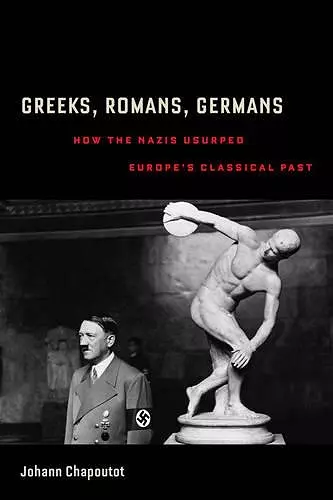Greeks, Romans, Germans
How the Nazis Usurped Europe's Classical Past
Johann Chapoutot author Richard R Nybakken translator
Format:Paperback
Publisher:University of California Press
Published:28th Oct '16
Currently unavailable, our supplier has not provided us a restock date

Much has been written about the conditions that made possible Hitler's rise and the Nazi takeover of Germany, but when we tell the story of the National Socialist Party, should we not also speak of Julius Caesar and Pericles? Greeks, Romans, Germans argues that to fully understand the racist, violent end of the Nazi regime, we must examine its appropriation of the heroes and lessons of the ancient world. When Hitler told the assembled masses that they were a people with no past, he meant that they had no past following their humiliation in World War I of which to be proud. The Nazis' constant use of classical antiquity-in official speeches, film, state architecture, the press, and state-sponsored festivities-conferred on them the prestige and heritage of Greece and Rome that the modern German people so desperately needed. At the same time, the lessons of antiquity served as a warning: Greece and Rome fell because they were incapable of protecting the purity of their blood against mixing and infiltration. To regain their rightful place in the world, the Nazis had to make all-out war on Germany's enemies, within and without.
"Official Nazi racial doctrine inverted traditional analyses by interpreting antiquity as a product of Nordicism. Although Hitler, Himmler, Goebbels, and Speer understood the limited archaeological evidence of early German society differently, biological determinism (the struggle between races) defined the baseline of historical change. In this light, Rome declined as it shed its Nordic blood in battle against Carthage. Alexander the Great's empire declined as it absorbed foreign elements, including Persians. Beyond Max Weinreich's Hitler's Professors (1946), Chapoutot (Sorbonne) identifies largely German classicists and philologists, including Hans F. K. Günther and Joseph Vogt, who coupled social Darwinistic ideas and biological racism into their interwar publications on antiquity. Consistent with Michael Wildt's Hitler's Volksgemeinschaft (CH, Feb'13, 50-3486), the pre-war Nazi curriculum reforms, Berlin's Olympiastadion, the German pavilion for the Paris International Exposition in 1937, the Reichsautobahn, and Nuremberg's Reichsparteitagsgelände united Germans with an illustrious history and physical reminders of its continuity under Nazi leadership, generally, and Adolf Hitler, specifically. Although racial scientists and academics had established the foundations of biological racism decades earlier, Nazi party officials and pedagogues (for example, Dietrich Klagges) endorsed Nordicism in new textbooks and a revised secondary curriculum. In short, the Nazis usurped Europe's classical past. Summing Up: Highly recommended." -- D. A. Meier, Dickinson State University * CHOICE connect *
"Chapoutot brings together the cultural, ideological and historical threads between the Third Reich and the ancient past, as they were woven by Nazi thinkers . . . this is an ambitious, important book for any scholar working on Nazi ideology, precisely because of its synthetic power." * Journal of Contemporary History *
ISBN: 9780520292970
Dimensions: 229mm x 152mm x 33mm
Weight: 680g
520 pages